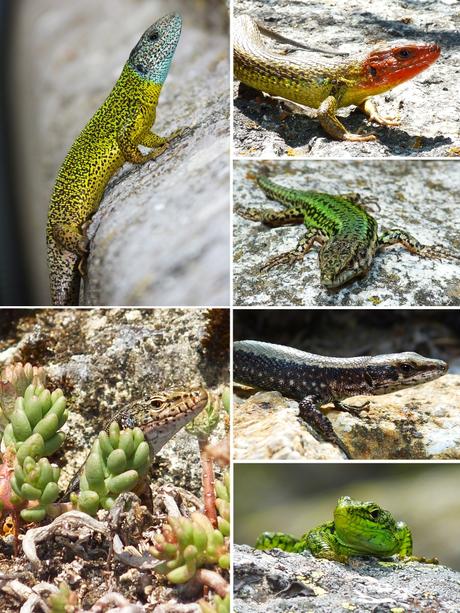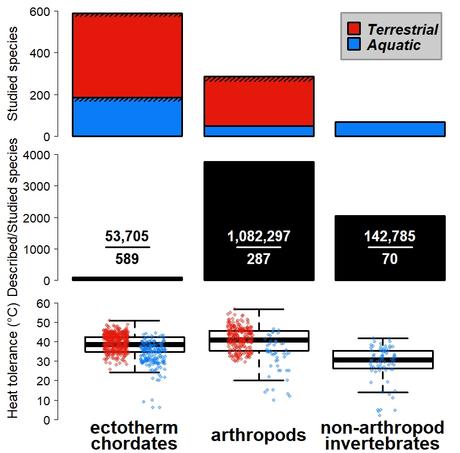Each organism has a limit of tolerance to cold and hot temperatures. So, the closer it lives to those limits, the higher the chances of experiencing thermal stress and potentially dying. In our recent paper, we revise gaps in the knowledge of tolerance to high temperatures in cold-blooded animals (ectotherms), a diverse group mostly including amphibians and reptiles (> 16,000 species), fish (> 34,000 species), and invertebrates (> 1,200,000 species).
As a scientist, little is more self-realising than to write and publish a conceptual paper that frames the findings of your own previous applied-research papers. This is the case with an opinion piece we have just published in Basic and Applied Ecology1 — 10 years, 4 research papers2-5 [see related blog posts here, here, here and here], and 1 popular-science article6 after I joined the Department of Biogeography and Global Change (Spanish National Research Council) to study the thermal physiology of Iberian lizards under the supervision of Miguel Araújo and David Vieites.

[left, top to bottom] Iberian emerald lizard (Lacerta schreiberi, from Alameda del Valle/Madrid) and Geniez’s wall lizard (Podarcis virescens, Fuertescusa/Cuenca), and [right, top to bottom] Algerian sand racer (Psammodromus algirus, Navacerrada/Madrid), Andalusian wall lizard (Podarcis vaucheri, La Barrosa/Cádiz), Valverde’s lizard (Algyroides marchi, Riópar/Albacete), and Cyren’s rock lizard (Iberolacerta cyreni, Valdesquí/Madrid). Heat-tolerance data deposited here and used to evaluate instraspecific variation of heat tolerance3,4. Photos: Salvador Herrando-Pérez.
In our new paper, we examine how much we know and what areas of research require further development to advance our understanding of how and why the tolerance of ectotherm fauna to high environmental temperature (‘heat tolerance’ hereafter) varies within and across the Earth’s biomes. We focus on data gaps using the global database GlobTherm as a reference template (see Box 1 below).
Our three main tenets
1. Population versus species data: Most large-scale ecophysiological research is based on modelling one measurement of heat tolerance per species (typically representing one population and/or physiological assay) over hundreds to thousands of species covering broad geographical, phylogenetic, and climatic gradients.
But there is ample evidence that heat tolerance changes a lot among populations occupying different areas of the distribution of a species, and such variation must be taken into account to improve our predictions of how species might respond to environmental change and face extinction.
2. Temperate-terrestrial vertebrates versus other taxa: Heat tolerance has been mostly measured in air-breathing vertebrates from temperate regions — a typical bias in the entire ecological literature7 because we (ecologists) tend to study large-bodied terrestrial animals that live near us (research power is concentrated in temperate regions).
We know comparatively little about the heat tolerance of invertebrate species, and measurements are scant from the Canadian and Russian boreal zones, the African and Asian tropics, the Indian Ocean and the poles, and the entire mesopelagic and deep ocean. Those regions represent some of the Earth’s most thermally extreme areas and invertebrates comprise > 90% of known biodiversity, and await future sampling efforts.
3. Temperature versus other climatic factors: The investigation of heat tolerance under climate change has largely addressed the effects of temperature. However, climate change is a multidimensional phenomenon such that the heat tolerance of a species responds to multiple, interacting climatic factors — not only temperature.

The known (upper panel) is the number of ectotherm chordate and invertebrate species for which heat tolerance has been measured following records from the database GlobTherm13 — line textile within bars indicates the number of species with one single measurement. The unknown (middle panel) is the ratio of described* to studied species. Thus, of 53,705 chordates described, we have measured heat tolerance in 589; that is, 1 of every 75 species. And for invertebrates, we have measured it in 1 of every 3,800 and 2,100 arthropod and non-arthropod species. In the lower panel, each little circle represents heat tolerance of each species (< 60 °C), and the thick-black line in each box shows the median heat tolerance across species in the three groups (30-40 °C). *Number of described species retrieved from The Catalogue of Life17 on 01/01/2020, and ‘aquatic’ refers to species spending their entire life cycle in water.
We underline two of those factors. On land, the availability of water (liquid water and vapour) shapes how terrestrial species cope with thermal stress. Likewise, we largely ignore the mechanisms driving the relationship between the oxygen supply-demand and species’ heat tolerances in the oceans. Describing clines of heat tolerance requires that the effects of interacting environmental factors are carefully considered in aquatic and terrestrial ecosystems.
Ultimately, we remark that “… global efforts to compile and analyze ecophysiological data for global change ecology have already been massive and a trade-off will always exist between data breadth and depth. The greater the breadth, the lower the depth — it is hard to circumvent this reality”1.
For prospecting biodiversity from the seas and the oceans, marine ecologists have advocated for stratified sampling by rates of biological activity, so that less effort should be put in deeper relative to shallower habitats8. But this approach might not level with bioprospecting physiological diversity because extreme habitats might not necessarily be species-diverse, but host extraordinary adaptations to tolerate extreme temperatures.
We really need to be imaginative about how to sample the regions and taxonomic groups currently neglected in ecophysiological research to cover truly global gradients of thermal tolerance in a comprehensive, yet cost-effective manner.
Box 1 — GlobTherm: In the face of global warming, it is reasonable to wonder how many species have we measured the maximum temperatures they can tolerate, which can be a useful proxy for their risk of extinction. In 2018, Scientific Data published the description of GlobTherm, a dataset of physiological tolerances to high (heat tolerance) and low (cold tolerance) temperatures — an initiative fueled by the German Centre for Integrative Biodiversity Research (iDiv), led by ecologist Joanne Bennett13. The dataset itself can be freely dowloaded here. GlobTherm currently hosts measurements for 2,133 species of multicellular algae, plants, fungi and animals from all over the planet. The best-studied chordates and invertebrates are reptiles and hymenopters (ants, bees, wasps), respectively, the best-studied regions are in temperate America and Europe, and measurements of heat tolerance of terrestrial species outnumber those of aquatic species.
The champion of heat tolerance in the animal kingdom is the Pompeii worm (Alvinella pompejana), a ‘bristle worm’ or ‘polychaete’ living in hydrothermal vents in the deep Pacific [see videos here and here], known to prefer and thrive in water temperatures beyond 40 °C14. However, no eukaryote can complete its life cycle at temperatures beyond 60 °C15. Essentially, sustained exposure to temperatures above the threshold of thermal tolerance is lethal as the oxygen demand is too high and the cell’s repair mechanisms collapse16.
Science always needs more data … but society should focus on risks
A note of caution applies here beyond the content of our paper. Big numbers about features of the Earth’s biodiversity, as those collated in GlobTherm, can in fact hinder our responses to environmental challenges. Psychologists have shown that public compassion wanes as the death toll escalates in an accident, catastrophe or conflict; for instance, the death of one child can trigger much more social, media, and political reaction than the slaughter of thousands of people in war9.
Regarding nature, people are ready to volunteer more, and donate more money, to protect one panda versus eight, one polar bear versus an entire population10; and the recent report about the state of the planet’s biodiversity11 is prone to ‘compassion fade’ by stating that 1 million species are threatened by extinction [see video], even though we have measured extinction risk for only some 100,000 species alone12.
The reality is that, whether there are more or fewer threatened species, or whether we study the ecological and physiological traits of more or fewer species, we already know that burning fossil fuels, ecosystem overexploitation, invasive species, and habitat destruction and pollution all negatively impact biodiversity and the ecosystem services they provide (see video voiced by David Attenborough).
We don’t need more science for ascertaining that fact.
As a society, our focus should be on addressing here and now the ongoing climatic and ecological risks, without being distracted by the current state of scientific knowledge, which will keep growing endlessly.
Acknowledgements
Our research was funded by the British Ecological Society, the Spanish Ministry of Science and the European Union’s Horizon 2020.
References
- Herrando-Pérez S, Vieites, DR & Araújo, MB (2023). Novel physiological data needed for progress in global change ecology. Basic and Applied Ecology doi:10.1016/j.baae.2023.01.002
- Herrando-Pérez S et al. (2020). Water deprivation drives intraspecific variability in lizard heat tolerance. Basic and Applied Ecology 48: 37-51
- Herrando-Pérez S et al. (2019). Intraspecific variation in lizard heat tolerance alters estimates of climate impact. Journal of Animal Ecology 88: 247-257
- Herrando-Pérez S et al. (2020). Heat tolerance is more variable than cold tolerance across species of Iberian lizards after controlling for intraspecific variation. Functional Ecology 34: 631-645
- Herrando-Pérez S et al. (2019). Statistical language backs conservatism in climate-change assessments. BioScience 69: 209-219
- Herrando-Pérez S & Vieites, DR (2020). Más ciencia no implica mejor estrategia climática. Quercus 410: 48-50
- Titley MA, Snaddon, JL & Turner, EC (2017). Scientific research on animal biodiversity is systematically biased towards vertebrates and temperate regions. PLoS ONE 12: e0189577
- Costello MJ et al. (2018). Stratifying ocean sampling globally and with depth to account for environmental variability. Scientific Reports 8: 11259
- Västfjäll D et al. (2014). Compassion fade: affect and charity are greatest for a single child in need. PLoS ONE 9: e100115
- Markowitz EM et al. (2013). Compassion fade and the challenge of environmental conservation. Judgment and Decision Making 8: 397-406
- Díaz S et al. (2019). Summary for Policymakers of the Global Assessment Report on Biodiversity and Ecosystem Services.(Intergovernmental Science-Policy Platform on Biodiversity and Ecosystem Services (IPBES)
- Costello MJ (2019). Unhelpful inflation of threatened species. Science 365: 332-333
- Bennett JM et al. (2018). GlobTherm, a global database on thermal tolerances for aquatic and terrestrial organisms. Scientific Data 5: 180022
- Ravaux J et al. (2013). Thermal limit for metazoan life in question: In vivo heat tolerance of the Pompeii worm. PLoS ONE 8: e64074
- Clarke A (2014). The thermal limits to life on Earth. International Journal of Astrobiology 13: 141-154
- Pörtner HO (2002). Climate variations and the physiological basis of temperature dependent biogeography: systemic to molecular hierarchy of thermal tolerance in animals. Comparative Biochemistry and Physiology Part A: Molecular & Integrative Physiology 132: 739-761
- Roskov Y et al. (2019). Species 2000 & ITIS Catalogue of Life: 2019 Annual Checklist. Species 2000: Naturalis, Leiden, The Netherlands

